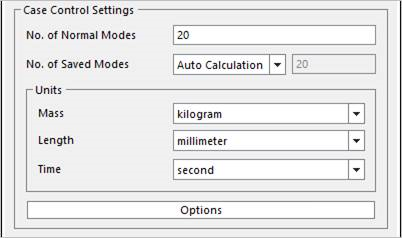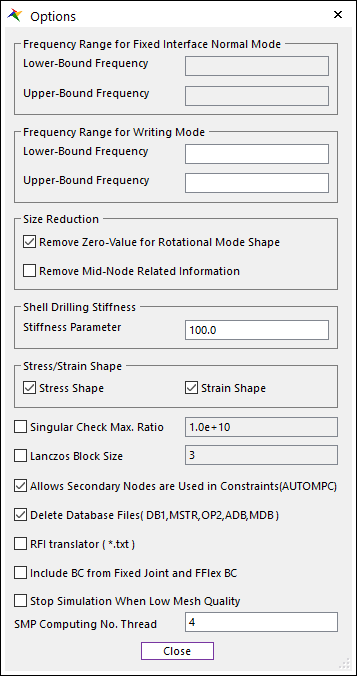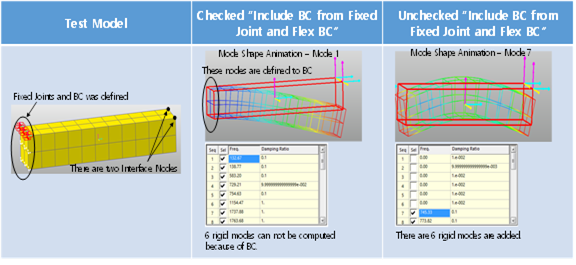11.2.2.4. Case Control Settings
This is to define the normal modes of a RFI file and the units that should be used about FE-Data when generating a RFI file.

Figure 11.43 The Case Control Settings group
No. of Normal Modes: Set the number of normal modes.
No. of Saved Modes: Set the number of modes for writing in the output RFI file. Following options are available.
Auto Calculation: Minimum value among following values
200
Number of normal modes + Number of interface nodes \(\times\) 6
Number of normal modes + Number of constraint modes in the “Set DOFs” function
User Definition: User can set the number of saved modes.
Units: If user uses the Nastran Bulk File option, all of the input FE-data (*.bdf or *.dat file) must be set with combination of the selected Mass, Length and Time unit. If user selects the Select Flexible Body option, all data are converted as the current RecurDyn Units.
Mass unit: Set a mass unit of input data.
Length unit: Set a length unit of input data.
Time unit: Set a time unit of input data.
Options: User can change several options related to generating a RFI. It is possible to define the related Frequency Range and the RFI Size Reduction options as shown bellows.
11.2.2.4.1. Options
User can change several options related to generating a RFI.

Figure 11.44 Options dialog box
Frequency Range of Fixed Interface Normal Mode: If the number of interface node is one or more than one, then this frequency range can be set. The default value is blank.
Frequency Range for Writing Mode: User can set a frequency range. If user set the frequency range, then the frequency of all written modes must be greater than low-bound frequency and must be lower than upper-bound frequency. The default value is blank.
Size Reduction: The size of output RFI file can be reduced with these options. For more information, click here.
Shell Drilling Stiffness: This parameter is needed to set the normal rotational stiffness for shell type elements of Sunshine. And this is similar to “K6ROT” parameter of Nastran. A value between 1.0 and 100.0 is recommended. The default value is 100.0. If user wants to get a more stiffen on the normal rotational stiffness, set a value more than 100.0
Stress/Strain Shape: This option supports to add stress and/or strain shapes to the generated RFI file. Default is checked.
Stress shape: The stress shapes should be included in the RFI file.
Strain shape: The strain shapes should be included in the RFI file.
Singular Check Max. Ratio
If the checkbox is unchecked, then “PARAM, BAILOUT=-1” is written in the RFlexGen solver input file. The RFlexGen Solver trying to solve despite any singularity detection during factorization.
If the checkbox is checked, then the user set the maximum ratio value and the “PARAM, MAXRATIO=User defined maximum ratio” is written in the RFlexGen solver input file. The default maximum ratio is 1.0e+10. When the RFlexGen solver detects a singular, which is defined as the ratio of the diagonal and off-diagonal values are greater than the user defined maximum ratio in the factorization, then the RFlexGen is stopped by the singular error.
Lanczos Block Size: User can change the lanczos block size of an eigen solver of the Sunshine. When an eigen solver error occurred with following message on the LOG file, then user can try with another blocksize. (The default is 3. A bigger blocksize would be better.)
Error(20099):Eigenvalue AnalysisLanczos eigensolver failed. Please try one of suggestions below.1)Change lanczos blocksize.2)This error may occur if the initial shift is close to zero and the modelhas rigid body modes. Try setting lower limit of frequency range tonegative value (e.g.-1) to force better selection of the initial shift.3)Try changing the value of param, invlan (yes or no)Allows Secondary Nodes are Used in Constraint (AUTOMPC): If this option is used, then the Modal or CMS analysis is available when some secondary nodes are used in the two or more RBEs (Rigid body elements) like as Figure 11.45.

Figure 11.45 Sharing secondary nodes in multi-point constraints
Delete Database Files (*.DB1, *.MSTR, *OP2): If this option is checked, the database files are automatically removed.
RFI translator (*.txt): If this option is checked, Sunshine makes a debugging text file(*.txt) after generating the RFI file. All data of *.txt files are translated from the RFI file. If the total number of nodes is greater than 10,000, the information about nodes, elements, mode shapes, stress shapes, and strain shapes are not written in the debugging text files.
Include BC from Fixed Joint and Flex BC: When Select Flexible Body is used in Mesh Data Type and this option is selected, then all connected nodes with Fixed Joint and all related nodes with FFlex/BC are defined to BC for the RFlexGen Solver. Default is unchecked.

Figure 11.46 An effect of the Include BC from Fixed Joint and Flex BC option
Stop Simulation When Low Mesh Quality : When this option is checked, then the Sunshine doesn’t simulate when some violations of the mesh quality are detected. The mesh quality report is written in *.INFO file.
SMP Computing No. Thread : User can change the number of threads for SMP computing. The default value is 4.
Note
Shell9 and Solid26 elements are not supported in RFlexGen. So, if the user sets mid nodes to the BC, RecurDyn give a waring message as bellows.
Warning
Mid-nodes cannot be included to the Interface Node or the BC of the RFlexGen. The selected Mid-nodes are automatically ignored in the RFlexGen.